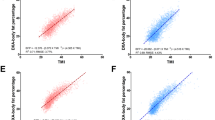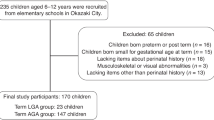Abstract
Background/objectives
Children with cerebral palsy (CP) are at risk for having a misclassified overweight/obesity status based on BMI thresholds due to their lower fat-free mass and similar fat mass compared with typically developing children. The primary objective was to determine if BMI could predict fat mass index (FMI) and fat-free mass index (FFMI) in children with CP.
Subjects/methods
Forty-two children with CP and 42 typically developing children matched to children with CP for age and sex participated in the study. Dual-energy X-ray absorptiometry was used to assess body composition. Children with CP who could ambulate without assistance were considered ambulatory (ACP) and the rest were considered nonambulatory (NACP).
Results
Children with CP had higher percent body fat (%Fat) and FMI and lower fat-free mass and FFMI than controls (p < 0.05) but no difference in fat mass (p = 0.10). When BMI was statistically controlled, NACP had higher %Fat, fat mass and FMI and lower FFMI than ACP and controls (p < 0.05). NACP also had lower fat-free mass than controls (p < 0.05). ACP had higher %Fat and FMI and lower fat-free mass and FFMI than controls (p < 0.05). BMI was a strong predictor of FMI (r2 = 0.83) and a moderately strong predictor of FFMI (r2 = 0.49) in children with CP (both p < 0.01). Prediction of FMI (R2 = 0.86) and FFMI (R2 = 0.66) from BMI increased (p < 0.05) when age, sex and ambulatory status were included.
Conclusion
Compared with typically developing children, children with CP have a higher FMI and lower FFMI for a given BMI, which is more pronounced in NACP than ACP. The finding suggests that the prevalence of overweight/obesity status may be underestimated in children with CP.
This is a preview of subscription content, access via your institution
Access options
Subscribe to this journal
Receive 12 print issues and online access
$259.00 per year
only $21.58 per issue
Buy this article
- Purchase on Springer Link
- Instant access to full article PDF
Prices may be subject to local taxes which are calculated during checkout



Similar content being viewed by others
References
Ogden CL, Carroll MD, Lawman HG, Fryar CD, Kruszon-Moran D, Kit BK, et al. Trends in obesity prevalence among children and adolescents in the United States, 1988–1994 through 2013–2014. J Am Med Assoc. 2016;315:2292–9.
Qi Q, Hua S, Perreira KM, Cai J, Van Horn L, Schneiderman N, et al. Sex differences in associations of adiposity measures and insulin resistance in US Hispanic/Latino youth: the Hispanic Community Children’s Health Study/Study of Latino Youth (SOL Youth). J Clin Endocrinol Metab. 2016;102:185–94.
Ortega FB, Sui X, Lavie CJ, Blair SN. Body mass index, the most widely used but also widely criticized index: would a criterion standard measure of total body fat be a better predictor of cardiovascular disease mortality? Mayo Clin Proc. 2016;91:443–55.
Boeke CE, Oken E, Kleinman KP, Rifas-Shiman SL, Taveras EM, Gillman MW. Correlations among adiposity measures in school-aged children. BMC Pediatr. 2013;13:99.
Walker JL, Bell KL, Stevenson RD, Weir KA, Boyd RN, Davies PS. Differences in body composition according to functional ability in preschool-aged children with cerebral palsy. Clin Nutr. 2015;34:140–5.
Stallings VA, Cronk CE, Zemel BS, Charney EB. Body composition in children with spastic quadriplegic cerebral palsy. J Pediatr. 1995;126:833–9.
Oftedal S, Davies PS, Boyd RN, Stevenson RD, Ware RS, Keawutan P, et al. Body composition, diet, and physical activity: a longitudinal cohort study in preschoolers with cerebral palsy. Am J Clin Nutr. 2017;105:369–78.
Bell KL, Davies PS. Energy expenditure and physical activity of ambulatory children with cerebral palsy and of typically developing children. Am J Clin Nutr. 2010;92:313–9.
Stallings VA, Zemel BS, Davies JC, Cronk CE, Charney EB. Energy expenditure of children and adolescents with severe disabilities: a cerebral palsy model. Am J Clin Nutr. 1996;64:627–34.
Rogozinski BM, Davids JR, Davis RB, Christopher LM, Anderson JP, Jameson GG, et al. Prevalence of obesity in ambulatory children with cerebral palsy. J Bone Jt Surg Am. 2007;89:2421–6.
Pascoe J, Thomason P, Graham HK, Reddihough D, Sabin MA. Body mass index in ambulatory children with cerebral palsy: A cohort study. J Paediatr Child Health. 2016;52:417–21.
Hurvitz EA, Green LB, Hornyak JE, Khurana SR, Koch LG. Body mass index measures in children with cerebral palsy related to gross motor function classification: a clinic-based study. Am J Phys Med Rehabil. 2008;87:395–403.
Johnson DL, Miller F, Subramanian P, Modlesky CM. Adipose tissue infiltration of skeletal muscle in children with cerebral palsy. J Pediatr. 2009;154:715–20.
Modlesky CM, Kanoff SA, Johnson DL, Subramanian P, Miller F. Evaluation of the femoral midshaft in children with cerebral palsy using magnetic resonance imaging. Osteoporos Int. 2009;20:609–15.
Whitney DG, Singh H, Miller F, Barbe MF, Slade JM, Pohlig RT, et al. Cortical bone deficit and fat infiltration of bone marrow and skeletal muscle in ambulatory children with mild spastic cerebral palsy. Bone. 2017;94:90–97.
Wells JC. A critique of the expression of paediatric body composition data. Arch Dis Child. 2001;85:67–72.
Wells JC, Coward WA, Cole TJ, Davies PS. The contribution of fat and fat-free tissue to body mass index in contemporary children and the reference child. Int J Obes Relat Metab Disord. 2002;26:1323–8.
Freedman DS, Wang J, Maynard LM, Thornton JC, Mei Z, Pierson RN, et al. Relation of BMI to fat and fat-free mass among children and adolescents. Int J Obes. 2005;29:1–8.
VanItallie TB, Yang MU, Heymsfield SB, Funk RC, Boileau RA. Height-normalized indices of the body’s fat-free mass and fat mass: potentially useful indicators of nutritional status. Am J Clin Nutr. 1990;52:953–9.
Rawal R, Miller F, Modlesky CM. Effect of a novel procedure for limiting motion on body composition and bone estimates by dual-energy X-ray absorptiometry in children. J Pediatr. 2011;159:691–4 e2.
Modlesky CM, Cavaiola ML, Smith JJ, Rowe DA, Johnson DL, Miller F. A DXA-based mathematical model predicts midthigh muscle mass from magnetic resonance imaging in typically developing children but not in those with quadriplegic cerebral palsy. J Nutr. 2010;140:2260–5.
Kuczmarski RJ, Ogden CL, Grummer-Strawn LM, Flegal KM, Guo SS, Wei R, et al. CDC growth charts: United States. Adv Data. 2000;314:1–27.
Stevenson RD. Use of segmental measures to estimate stature in children with cerebral palsy. Arch Pediatr Adolesc Med. 1995;149:658–62.
Miller F, Koreska J. Height measurement of patients with neuromuscular disease and contractures. Dev Med Child Neurol. 1992;34:55–60.
Wood E, Rosenbaum P. The gross motor function classification system for cerebral palsy: a study of reliability and stability over time. Dev Med Child Neurol. 2000;42:292–6.
Cohen J. Statistical power for the behavioral sciences. 2nd ed. Hillsdale, NJ: Lawrence ErlBaum Associates; 1988.
Hawkins DM, Basak SC, Mills D. Assessing model fit by cross-validation. J Chem Inf Comput Sci. 2003;43:579–86.
Ryan JM, Crowley VE, Hensey O, McGahey A, Gormley J. Waist circumference provides an indication of numerous cardiometabolic risk factors in adults with cerebral palsy. Arch Phys Med Rehabil. 2014;95:1540–6.
Strauss D, Cable W, Shavelle R. Causes of excess mortality in cerebral palsy. Dev Med Child Neurol. 1999;41:580–5.
Cremer N, Hurvitz EA, Peterson MD. Multimorbidity in middle-aged adults with cerebral palsy. Am J Med. 2017;130:744.e9–e15.
Finbraten AK, Martins C, Andersen GL, Skranes J, Brannsether B, Juliusson PB, et al. Assessment of body composition in children with cerebral palsy: a cross-sectional study in Norway. Dev Med Child Neurol. 2015;57:858–64.
Modlesky CM, Lewis RD, Yetman KA, Rose B, Rosskopf LB, Snow TK, et al. Comparison of body composition and bone mineral measurements from two DXA instruments in young men. Am J Clin Nutr. 1996;64:669–76.
Weber DR, Leonard MB, Shults J, Zemel BS. A comparison of fat and lean body mass index to BMI for the identification of metabolic syndrome in children and adolescents. J Clin Endocrinol Metab. 2014;99:3208–16.
Sullivan PB, Juszczak E, Bachlet AM, Lambert B, Vernon-Roberts A, Grant HW, et al. Gastrostomy tube feeding in children with cerebral palsy: a prospective, longitudinal study. Dev Med Child Neurol. 2005;47:77–85.
Weber DR, Moore RH, Leonard MB, Zemel BS. Reply to RF Burton. Am J Clin Nutr. 2013;98:1368–9.
Burton RF. The fat mass index: why its height exponent should be 3 and not 2. Am J Clin Nutr. 2013;98:1367.
Rimmer JH, Yamaki K, Lowry BM, Wang E, Vogel LC. Obesity and obesity-related secondary conditions in adolescents with intellectual/developmental disabilities. J Intellect Disabil Res. 2010;54:787–94.
Acknowledgements
The study was supported by the National Institutes of Health (HD071397, HD050530 and HD090126) and the National Osteoporosis Foundation. We thank all research participants and their families. We thank Patricia Groves and Keri DiAlessandro for their assistance with testing and Nancy Lennon for assistance with recruitment. Parts of this manuscript are also available online as part of a dissertation: http://dspace.udel.edu/bitstream/handle/19716/23077/Whitney_udel_0060D_12949.pdf?sequence=1&isAllowed=y.
Author information
Authors and Affiliations
Corresponding author
Ethics declarations
Conflict of interest
The authors declare that they have no conflict of interest.
Rights and permissions
About this article
Cite this article
Whitney, D.G., Miller, F., Pohlig, R.T. et al. BMI does not capture the high fat mass index and low fat-free mass index in children with cerebral palsy and proposed statistical models that improve this accuracy. Int J Obes 43, 82–90 (2019). https://doi.org/10.1038/s41366-018-0183-1
Received:
Revised:
Accepted:
Published:
Issue Date:
DOI: https://doi.org/10.1038/s41366-018-0183-1
This article is cited by
-
5-year fracture risk among children with cerebral palsy
Pediatric Research (2023)



